BUICK CENTURY 1993 Owners Manual
Manufacturer: BUICK, Model Year: 1993, Model line: CENTURY, Model: BUICK CENTURY 1993Pages: 324, PDF Size: 17.58 MB
Page 251 of 324
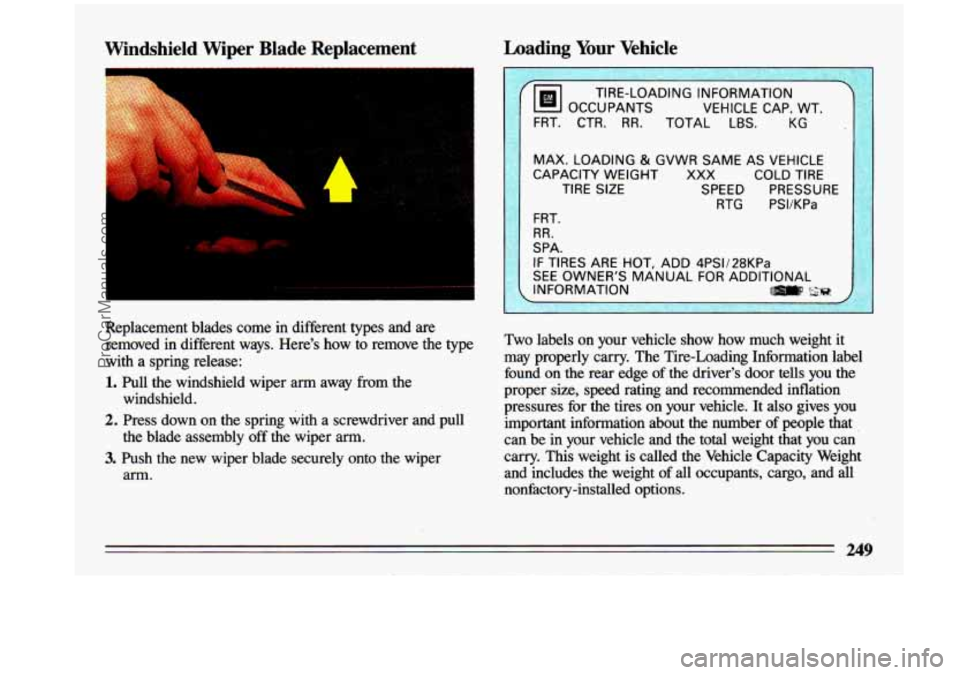
Windshield Wiper Blade Replacement
-1
Replacement blades come in different types and are
removed in different ways. Here’s how to remove the type
with a spring release:
1. Pull the windshield wiper arm away from the
2. Press down on the spring with a screwdriver and pull
3. Push the new wiper blade securely onto tL wiper
windshield.
the blade assembly off the wiper
arm.
arm.
Loading Your Vehicle
G INFORMATION
VEHICLE CAP. WT.
FRT. CTR.
RR. TOTAL LBS. KG
MAX. LOADING
& GVWR SAME AS VEHICLE
1 CAPACITY WEIGHT XXX COLD TIRE
TIRE SIZE SPEED PRESSURE
RTG PSI/KPa
Two labels on your vehicle show how much weight it
may properly carry. The Tire-Loading Information label
found on the rear edge of the driver’s door tells you the
proper size, speed rating and recommended inflation
pressures for the tires on your vehicle. It also gives you
important information about the number of people that
,
can be in your vehicle and the total weight that you can
carry. This weight is called the Vehicle Capacity Weight
and includes the weight
of all occupants, cargo, and all
nonfactory-installed options.
249
ProCarManuals.com
Page 252 of 324
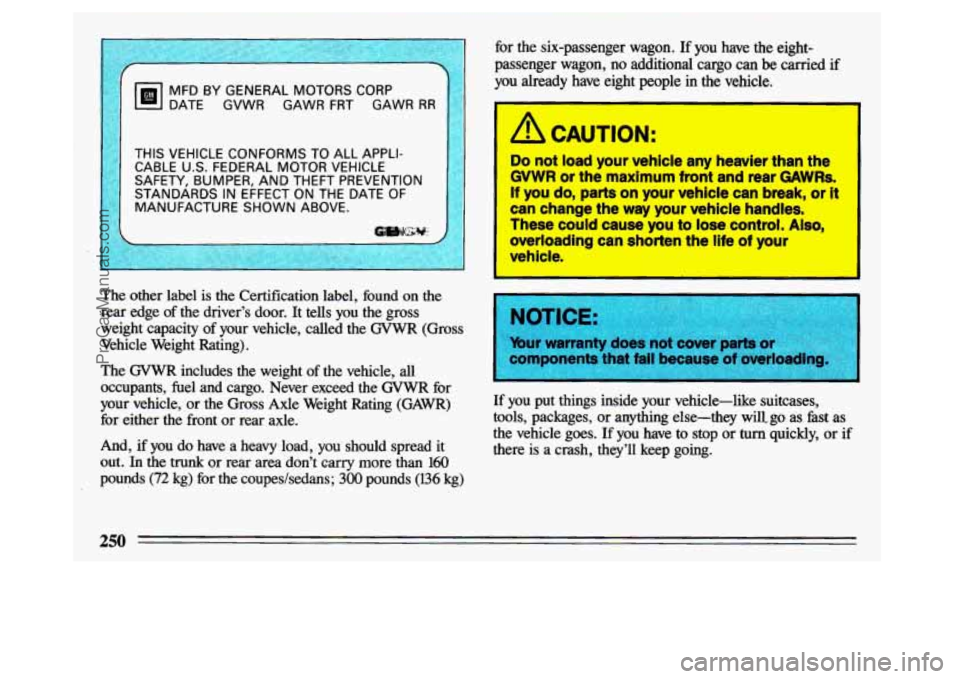
MFD BY GENERAL MOTORS CORP
DATE GVWR GAWR FRT GAWR
RR
THIS VEHICLE CONFORMS TO ALL APPLI- CABLE U.S. FEDERAL MOTOR VEHICLE
SAFETY, BUMPER, AND THEFT PREVENTION
STANDARDS IN EFFECT ON THE DATE OF
I MANUFACTURE SHOWN ABOVE. Qw&$;+#;
The other label is the Certification label, found on the
rear edge
of the driver’s door. It tells you the gross
weight capacity of your vehicle, called the GVWR (Gross
Vehicle Weight Rating).
The GVWR includes the weight of the vehicle, all
occupants, fuel and cargo. Never exceed the GVWR for
your vehicle, or the Gross Axle Weight Rating (GAWR)
for either the front or rear axle.
And, if you do have a heavy load, you should spread it
out.
In the trunk or rear area don’t carry more than 160
pounds (72 kg) for the coupeshedans; 300 pounds (136 kg) for the six-passenger wagon.
If you have the eight-
passenger wagon, no additional cargo
can be carried if
you already have eight people in the vehicle.
A CAUTION:
Do not load your vehicle any heavier than the
GVWR or the maximum front and rear GAWRs.
If you do, parts on your vehicle can brerak, or It
can change the way your vehicle handles.
These could cause you to lose control. Also,
overloading can shorten the life of your
vehicle.
If you put things inside your vehicle-like suitcases,
tools, packages, or anything else-they willgo as hst
as
the vehicle goes. If you have to stop or turn quickly, or if
there is a crash, they’ll keep
going.
250
ProCarManuals.com
Page 253 of 324
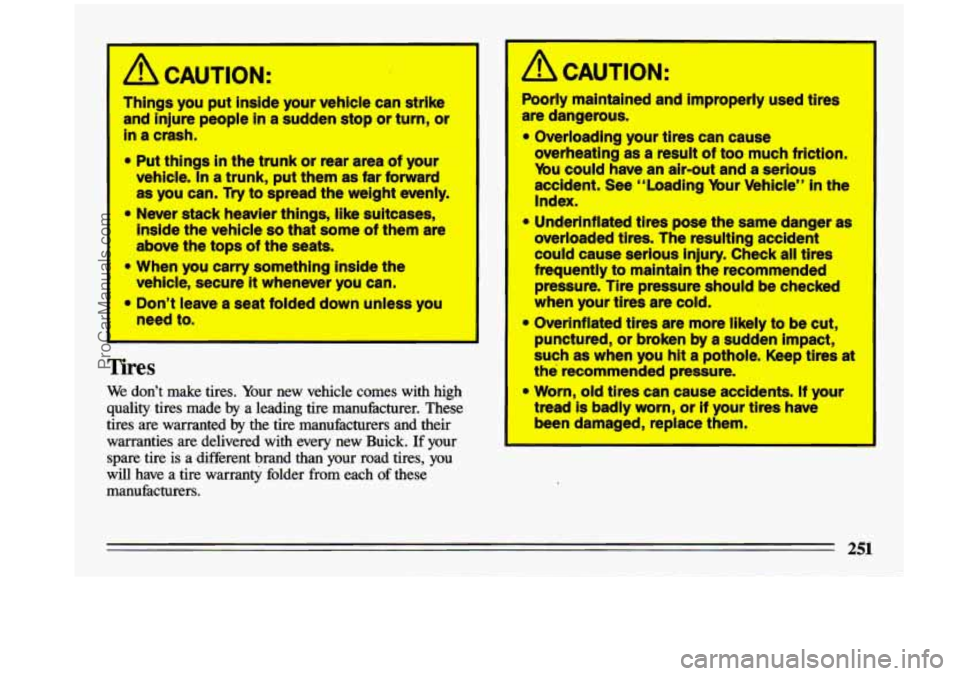
n
ACAUTION:
Things you put inside your vehicle can strike
and injure people
in a sudden stop or turn, or
In a crash.
* Put things In the trunk or rear area of your
vehicle. In
a trunk, put them as far forward
as you can. Try to spread the weight evenly.
* Never stack heavier things, IPke suitcases,
inside the vehicle
so that some of them are
above the tops
of the seats.
* When you carry something inside the
vehicle, secure
it whenever you can.
* Don’t leave a seat folded down unless you
need to.
Tires
We don’t make tires. Your new vehicle comes with high
quality tires made
by a leading tire manufacturer. These
tires are warranted by the tire manufacturers and their
warranties are delivered with every new Buick. If your spare tire is a different brand than your road tires, you
will have a tire warranty folder from each
of these
manufacturers.
A CAUTION:
Poorly maintained and improperly used tires
are dangerous.
0 Overloading your tires can cause
overheating as a ngsult
of too much friction.
Mu could
have an air-out and a serious
accident.
See “Loading bur Vehicle” in the
Index.
* Underlnflated tires pose the same danger as
overloaded tires. The resulting accident
could cause serious injury. Check
all tires
frequently to maintain the recornmended
pressure. Tire pressure should
be checked
when your tires are cold.
* Overinflated tires are more likely to be cut,
punctured, or broken
by a sudden Impact,
such as when you
hit a pothole. Keep tires at
the recommended pressure.
tread
Is badly worn, or If your tlps have
been damaged, replace them.
* Worn, old tires can cause accidents. If your
251
ProCarManuals.com
Page 254 of 324
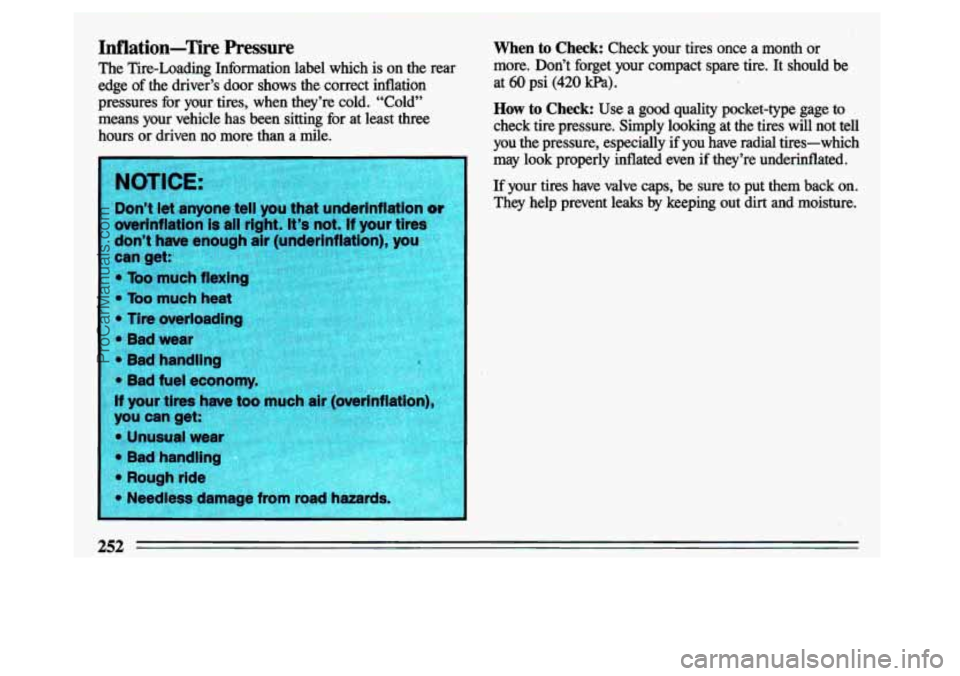
Inflation-Tire Pressure When to Check: Check your tires once a month’or
The Tire-Loading Inforlnation label which is on the rear
’ more. Don’t forget your compact spare tire. It should be
edge of the driver’s door shows
the correct inflation at 60 psi (420 kPa).
pressures for your tires, when they’re cold. “Cold”
means your vehicle has been sitting for at least
three
hours or driven no more than a ‘mile.
How to Check: Use a good quality pocket-type gage to
check tire pressure. Simply looking at the tires will not tell
you the pressure, especially if you have radial tires-which
may look properly inflated even if they’re underinflated.
If your tires have valve caps, be sure to put them back on. \
They help prevent
leaks by keeping out dirt and moisture.
252
ProCarManuals.com
Page 255 of 324
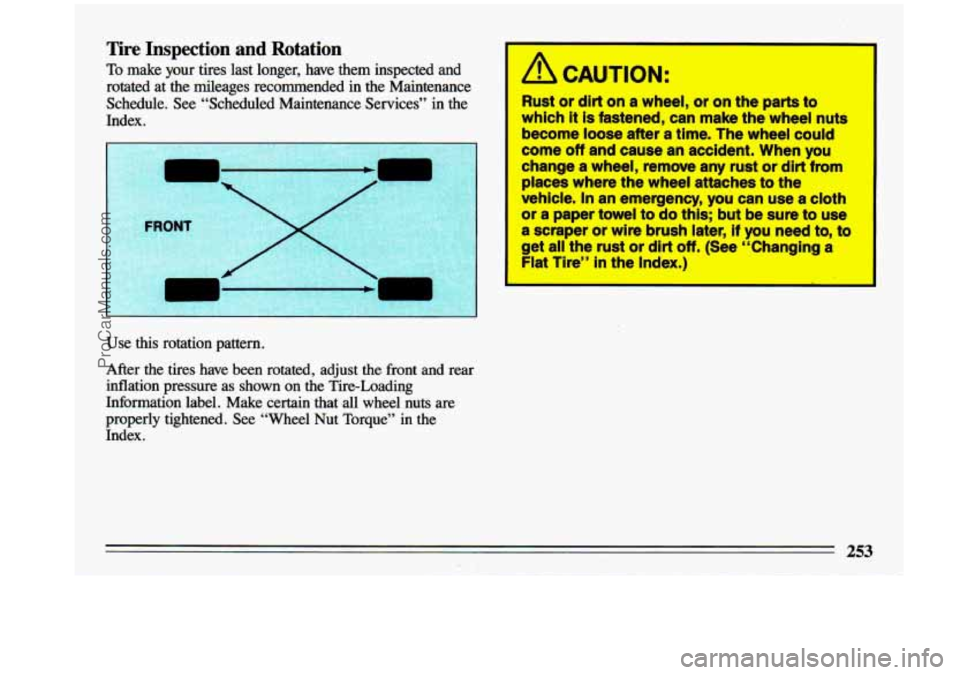
Tire Inspection and Rotation
To make your tires last longer, have them inspected and
rotated at the mileages recommended
in the Maintenance
Schedule. See “Scheduled Maintenance Services”
in the
Index.
Use this rotation pattern.
After the tires have been rotated, adjust the front and rear
inflation pressure as shown on the Tire-Loading
Information label. Make certain that -all wheel
nuts are
properly tightend. See “Wheel
Nut Torque” in the
Index.
1
I A CAUTION:
Rust or dirt on a wheel, or on the parts to
which
It Is fastened, can make the’wheel nuts
become loose after a Qlme. The wheel could
come off and cause an accident. When you
change a wheel, remove any rust or dirt from
places where the wheel attaches to the
vehlcle.
In an emergency, you can use a cloth
or a paper towel to do this; but be sure to us8
a scraper or wire brush later, if you need to, to
get
all the rust or dirt off. (See “Changing a
Flat Tlre” in the Index.)
253
ProCarManuals.com
Page 256 of 324
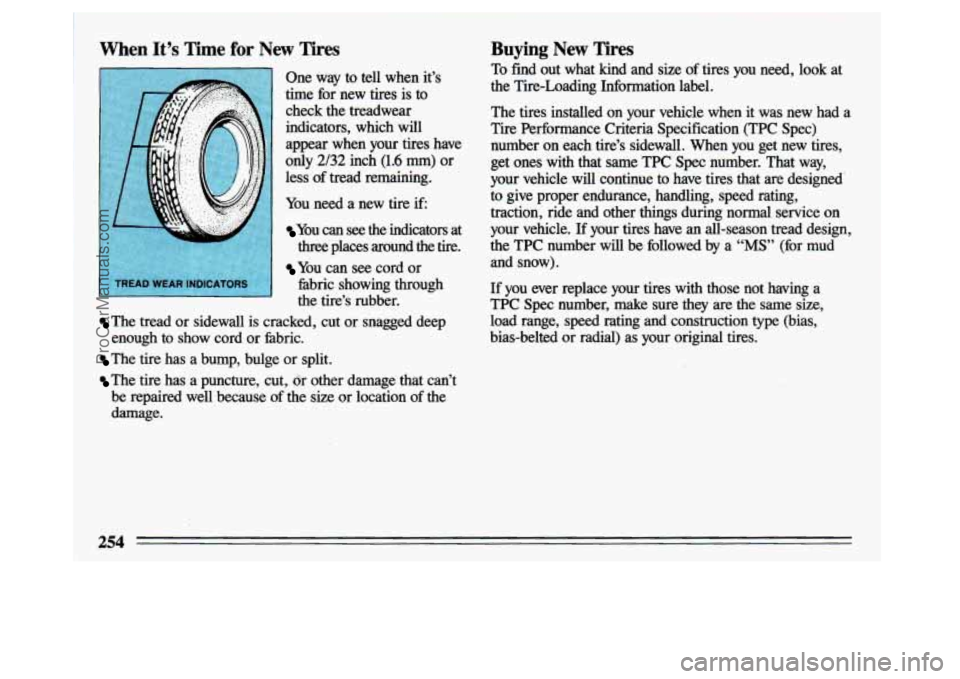
i
When It's Time for New Tires
One way to tell when it's
time for new
tires is to
check the treadwear
indicators, which will
appear when your tires have
only
2/32 inch (1.6 mm) or
less of tread remaining.
You need a new tire if
You can see the indicators at
three places around the tire.
You can see cord or
fabric showing through
the tire's rubber.
The tread or sidewall is cracked, cut or snagged deep
The tire has a bump, bulge or split.
The tire has a puncture, cut, or other damage that can't
be repaired well because of the size or location
of the
damage. enough to show cord
or fabric.
Buying New Tires
To find out what kind and size of tires you need, look at
the Tire-Loading Information label.
The tires installed on your vehicle when it was new .had a
Tire Performance Criteria Specification (TPC Spec)
number on each tire's sidewall. When you get new tires,
get ones with that same TPC
Spec number. That way,
your vehicle will continue to have tires that are designed'
to give proper endurance, handling, speed rating,
traction, ride and other things during normal service on
your vehicle.
If your tires have an all-season tread design,
the TPC number will be followed by a
"MS" (for mud
and snow).
If you ever replace your tires with those not having a
TPC Spec number, make sure they are the same
size,
load range, speed rating and construction type (bias,
bias-belted
or radial) as your original tires.
254
ProCarManuals.com
Page 257 of 324
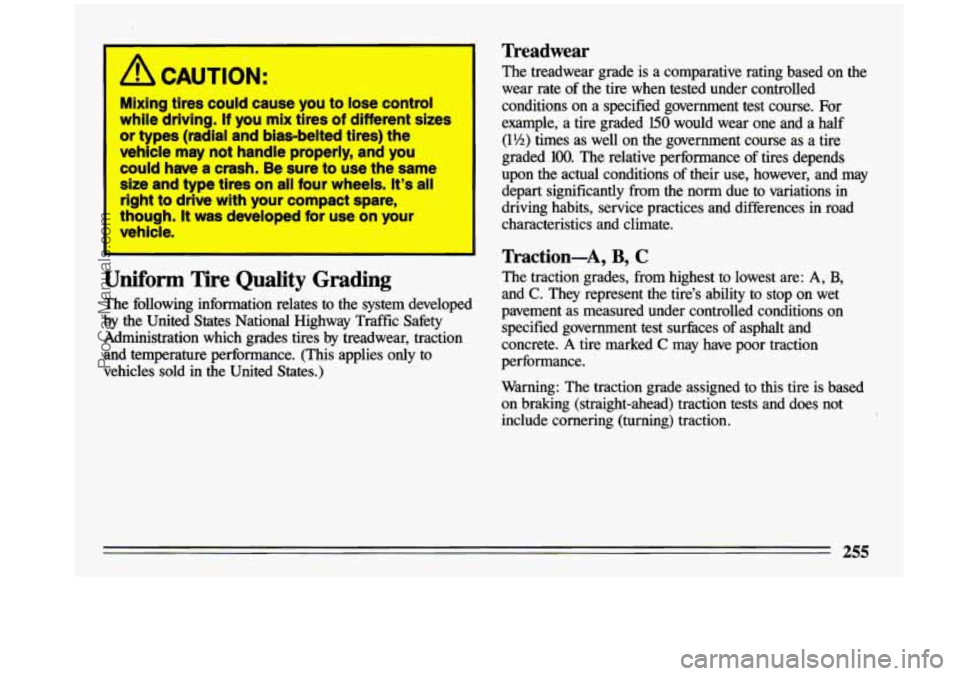
*
I A CAUTION:
Mlxing tires could cause you to lose control
while driving.
If you mlx tires of different sizes
or types (radial and bias-belted tires) the
vehlcle may not handle
properly, and you
could have
a crash. Be sure to use the same
size and type
tires on all four wheels. It’s all
right to drive wlth your compact spare,
though.
It was developed far use on your
vehicle.
I
Uniform Tire Quality Grading
The following information relates to the system developed
by the United States National Highway Traffic Safety
Administration which grades tires by treadwear, traction
and temperature performance. (This applies only to
vehicles
sold in the United States.)
Treadwear
The treadwear grade is a comparative rating based on the
wear rate of the tire when
tested under controlled
conditions on a specified government test course. For
example, a tire graded
150 would wear one and a half
(1%) times as well on the government course
as a tire
graded
100. The relative performance of tires depends
upon the actual conditions of their use, however, and may
depart significantly from the norm due to variations
in
driving habits, service practices and differences in road
characteristics and climate.
Traction-A, B, C
The traction grades, from highest to lowest are: A, B,
and C. They represent the tire’s ability to stop on wet
pavement as measured under controlled conditions on specified government test surfaces of asphalt and
concrete.
A tire marked C may have poor traction
performance.
Warning: The traction grade assigned to this tire is based
on braking (straight-ahead) traction tests and does not
include cornering (turning) traction.
255
ProCarManuals.com
Page 258 of 324
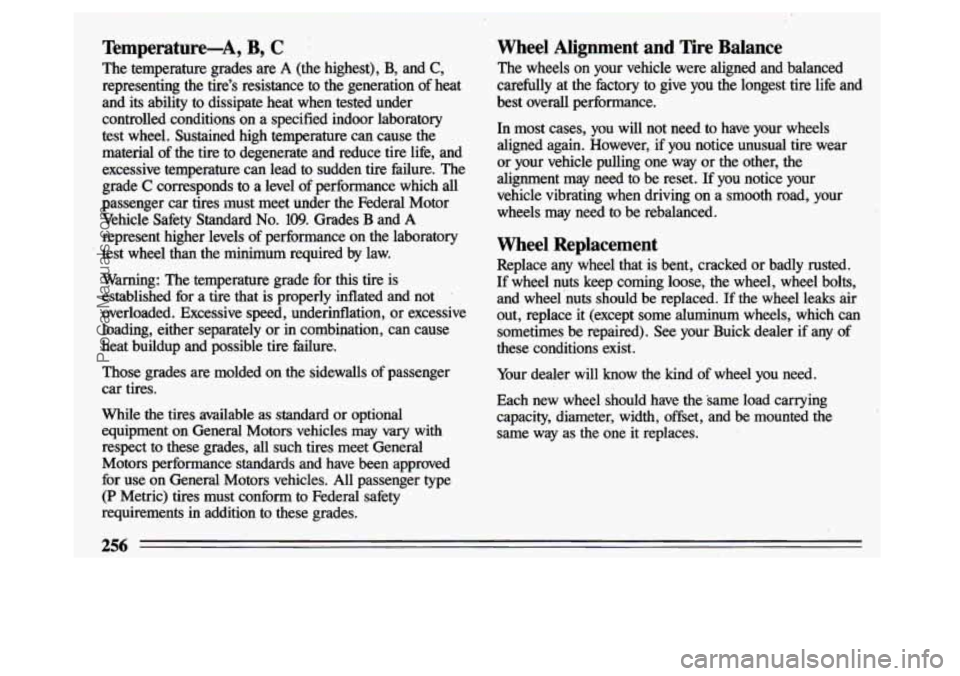
Temperature-A, B, C
The temperature grades are A (the highest), B, and C,
representing the tire's resistance to the generation of heat
and
its ability to dissipate heat when tested under
controlled conditions on a specified indoor laboratory
test wheel. Sustained high temperature can cause the material'of the tire to degenerate and reduce tire life, and
excessive temperature can lead to sudden tire failure. The
grade
C corresponds to a level of performance which all
passenger car tires must meet under the Federal Motor
Vehicle Safety Standard
No. 109. Grades B and A
represent higher levels of performance on the laboratory
test wheel than the minimum required by law.
Warning: The temperature grade for
this tire is
established for a tire that is properly inflated and
not
overloaded. Excessive speed, underinflation, or excessive
loading, either separately or in combination, can cause
heat buildup and possible tire failure.
Those grades are molded on the sidewalls of'passenger
car tires.
While the tires available as standard or optional
equipment on General Motors vehicIes may vary with
respect to these grades, all such tires meet General
Motors performance standards and have been approved
for use
on General Motors vehicles. All passenger type
(P Metric) tires must conform to Federal safety
requirements in addition to these grades.
Wheel Alignment and Tire Balance
The wheels on your vehicle were aligned and balanced
carefully at the, factory to give you the longest tire life and
best overall performance.
In most cases, you will not need to have your wheels
aligned again. However, if you-notice unusual tire wear
or your vehicle pulling one way or the other, the
alignment may need
to be reset. If you notice your
vehicle vibrating when driving on a
smooth road, your
wheels may need to be rebalanced.
Wheel Replacement
Replace any wheel that is bent, cracked or badly rusted.
If wheel nuts keep coming loose, the wheel, wheel bolts,
and wheel'nuts should be replaced. If the wheel leaks air
out, replace it (except some aluminum wheels, which can sometimes be repaired). See your Buick dealer
if any of
these conditions exist.
Your dealer will know the kind
of wheel you need.
Each new wheel should have the same load carrying
capacity, diameter, width, offset, and be mounted the same way as the one
it replaces.
256
ProCarManuals.com
Page 259 of 324
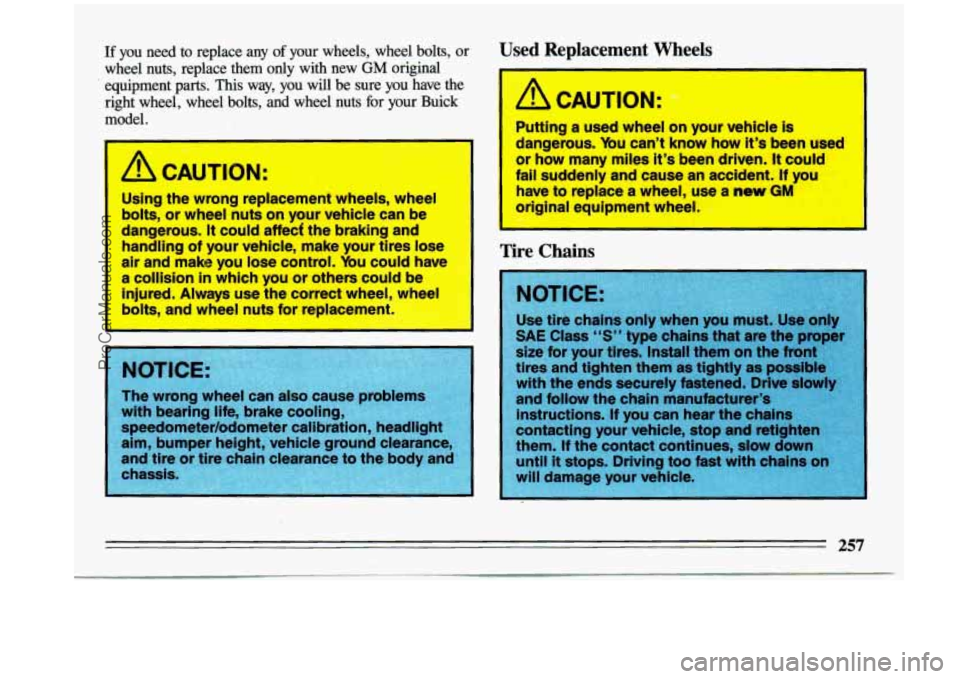
If you need to replace any of your wheels., wheel bolts, or
wheel nuts, replace them only with new
GM original
equipment parts. This way, you will be sure
you have the
right wheel, wheel bolts, and wheel nuts for your Buick
model.
A CAUTION:
Using the wrong replacement wheels, wheel
bolts, or wheel nuts on your vehicle can be
dangerous.
It could affecf the braking and
handling of your vehicle, make your tires lose
air and make you lose control. You could have
a collision in which you or others could be
injured. Always use the correct wheel, wheel
bolts,
and wheel nuts for replacement.
Used Replacement Wheels
Tire Chains
257
ProCarManuals.com
Page 260 of 324
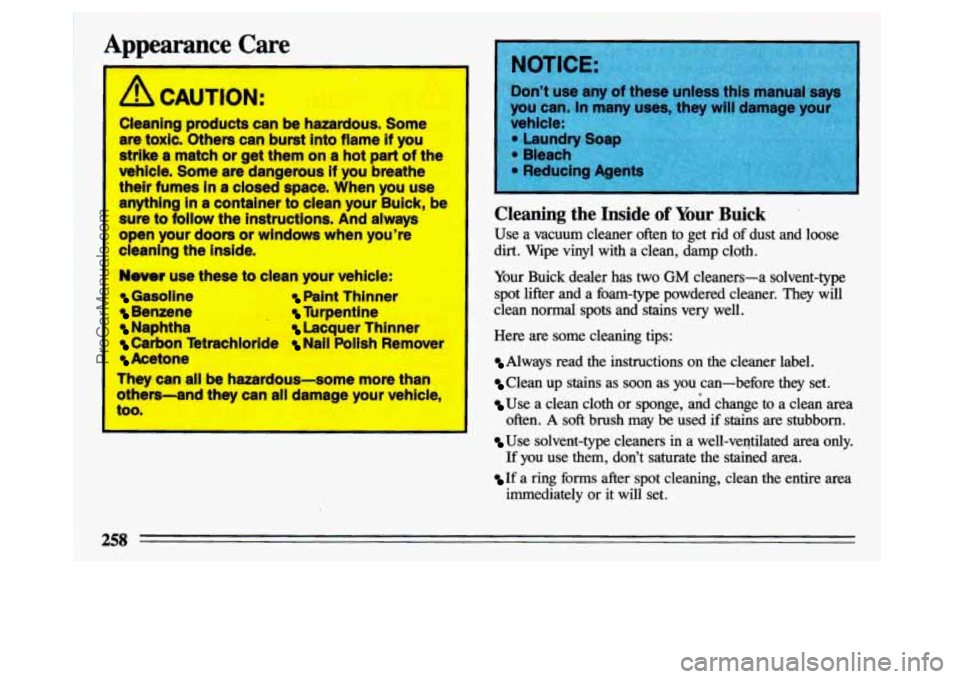
Appearance Care
A CAUTION:
Cleaning products can be hazardous. Some are
toxic. Others can burst into flame if you
strike
a match or get them on a hot part of the
vehicle. Some are dangerous if you breathe
their fumes in
a closed space. When you use
anything in a container to clean your Buick, be
sure to follow the instructions. And always
open your doors or windows when you're
cleaning the inside.
Never use these to clean your vehicle:
Gasoline Paint Thinner
Benzene Turpentine
Naphtha Lacquer Thinner
Carbon Tetrachloride Nail Polish Remover
Acetone
They can all be hazardous-some more than
others-and they can all damage your vehicle,
too.
Cleaning the Inside of Your Buick
Use a vacuum cleaner often to get rid of dust and loose
dirt. Wipe vinyl with a clean, damp cloth.
Your Buick dealer has two
GM cleaners-a solvent-type
spot lifter and a foam-type powdered cleaner. They
will
clean normal spots and stains very well.
Here
are some cleaning tips:
Always read the instructions on the cleaner label.
Clean up stains as soon as you can-before they set.
Use a clean cloth or sponge, &d change to a clean area
often.
A soft brush may be used if stains are stubborn.
Use solvent-type cleaners in a well-ventilated area only.
If you use them, don't saturate the stained area.
If a ring forms after spot cleaning, clean the entire area
immediately or it will set.
1 258
I
ProCarManuals.com